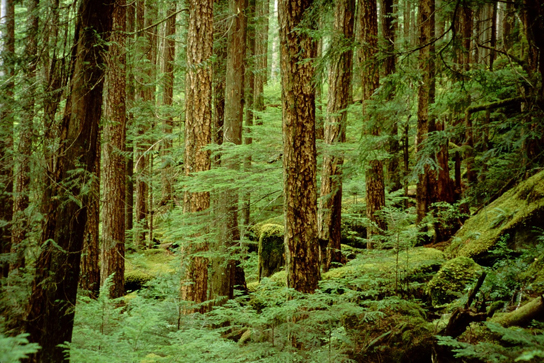| << Chapter < Page | Chapter >> Page > |
Many photosynthetic organisms have a mixture of pigments; using them, the organism can absorb energy from a wider range of wavelengths. Not all photosynthetic organisms have full access to sunlight. Some organisms grow underwater where light intensity and quality decrease and change with depth. Other organisms grow in competition for light. Plants on the rainforest floor must be able to absorb any bit of light that comes through, because the taller trees absorb most of the sunlight and scatter the remaining solar radiation ( [link] ).

When studying a photosynthetic organism, scientists can determine the types of pigments present by generating absorption spectra. An instrument called a spectrophotometer can differentiate which wavelengths of light a substance can absorb. Spectrophotometers measure transmitted light and compute from it the absorption. By extracting pigments from leaves and placing these samples into a spectrophotometer, scientists can identify which wavelengths of light an organism can absorb. Additional methods for the identification of plant pigments include various types of chromatography that separate the pigments by their relative affinities to solid and mobile phases.
When a compound absorbs a photon of light, the compound becomes "excited", in the sense that it has this extra energy. This is illustrated in figure 7 schematically. The compound has some ground state, it absorbs a photon and now contains this excess absorbed energy and is considered "excited". The question because what does the compound do with this excess absorbed energy and how does it get back to its "ground" state.

What does the excited atom or molecule do to return to its ground state. The energy in this molecule can then be dissipated in a variety of ways as the excited electron decays back to its ground state. There are four possible outcomes, which are schematically diagrammed in Figure 8 below. These energy options are:

As the excited electron decays back to its original orbit, the energy can be released in a variety of ways. While many of the antenna or auxiliary pigments absorb light energy and transfer it to the reaction center (as depicted in option III in figure 8) it is what happens at the reaction center that we are most concerned with (option IV in figure 8). Here a chlorophyll or bacteriochlorophyll molecule absorbs the energy and an electron is excited. This energy transfer is sufficient to allow the reaction center to donate the electron in a red/ox reaction to a second molecule. This initiates the photophosphorylation electron transport reactions. The result is an oxidized reaction center that must now be reduced in order to start the process again. How this happens is the basis of electron flow in photophosphorylation and will be described in detail below.

Notification Switch
Would you like to follow the 'Ucd bis2a intro to biology v1.2' conversation and receive update notifications?